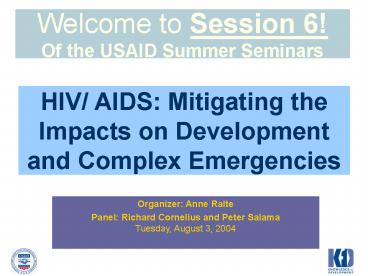HIVAIDS - PowerPoint PPT Presentation
1 / 14
Title:
HIVAIDS
Description:
'HIV/AIDS is one of the biggest challenges to development that we have ever faced. ... The HIV/AIDS pandemic is not just a health sector issue; it is the business of ... – PowerPoint PPT presentation
Number of Views:72
Avg rating:3.0/5.0
Title: HIVAIDS
1
Welcome to Session 6!Of the USAID Summer Seminars
HIV/ AIDS Mitigating the Impacts on Development
and Complex Emergencies
Organizer Anne Ralte Panel Richard Cornelius
and Peter SalamaTuesday, August 3, 2004
2
Mitigating the Impacts of HIV/AIDS in Key
Social Sectors
- Richard Cornelius
- Senior Policy Advisor for Health
- USAID Bureau for Policy and Program Coordination
3
Question Is HIV/AIDS a problem I need to worry
about in my sector?
- Answer YES!!!
- Reversal of development gains ? which exacerbates
the HIV/AIDS problem - Unsustainable depletion of manpower and capacity
4
HIV/AIDS is one of the biggest challenges to
development that we have ever faced. Our
response must be Agency-wide. The HIV/AIDS
pandemic is not just a health sector issue it is
the business of every officer in every sector in
the Agency. The design of activities in all
sectors should take into account the impact of
the HIV/AIDS pandemic on human and institutional
capacity in the sector. USAID Administrator
Andrew Natsios, 2001
5
PPC policy initiative for a development challenge
of increasing urgency and complexity
- Provide guidance to missions in high prevalence
countries for HIV impact mitigation in all sector
strategies - Facilitate assessment of HIV/AIDS impacts on key
social sectors - Guide missions on coordination of HIV impact
mitigation responses across sectors - Support international and host country research
capacity for decision making
6
Cumulative HIV impacts aggravate old development
problems in new ways
- Erosion of capacity in education
- KZN DOE needs 55,000 new teachers by 2010
- Zambia teacher mortality threatens quality of
education (lose 750-1000 teachers per year) - Decline in agricultural production
- household production may decline 60
- deepens regional food insecurity
7
Threatens national securityestimated percentage
of military personnel who are HIV-positive by
country
8
HR losses mean management and planning capacity
is weakened across all government departments
- Training needs change and increase
- Resource planning becomes more difficult in a
change environment - Essential services weaken or collapse, just when
the vulnerable need more - Self-reinforcing downward spiral with maturing
epidemic conditions
9
What can USAID Missions do?
- Establish a Mission working group to coordinate
mitigation activities across sectors (make them
mutually reinforcing) - Assess HIV impacts in each sector
- Help Ministries develop strategic plans for HIV
impact mitigation response in their sector - Help each SO incorporate low cost activities in
existing portfolio
10
What can USAID Missions do? (cont.)
- Support medium and long-term mitigation
activities according to sector priorities in
Ministry strategic plans, e.g., - Support for full-time HIV coordinating units
- Focused community support via agric. extension
service, community radio - Policy audits for systems reform, e. g.,
workplace HIV policies, financial training
11
Leverage initial support for local sector
assessment and planning deepens information base
for decisions, identifies priority actions, and
leverages resources
- Ministry strategic HIV plans attract resources of
host government and other donors funds (MAP,
Global Fund, WB) for high cost interventions - Builds capacity of host government to monitor
impacts of HIV as part of everyday sector
management - Builds local capacity to prioritize actions for
systemic response
12
What might health officers do to facilitate
mitigation interventions in non-health sectors?
- Help establish and participate in a Mission
working group on mitigation - Participate in local donor coordination
- Assist SOs in SOWs for sectoral impact
assessments - Facilitate links with NACP in health
13
(No Transcript)
14
For More Information
- Web Site
- http//www.usaid.gov
- Enter Keyword Summer Seminars
- or
- http//www.usaid.gov/policy/cdie/
- WEBBoard
- http//forums.info.usaid.gov/USAIDSummerSeminars































